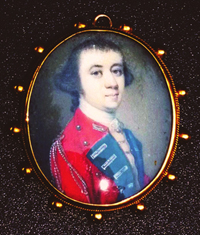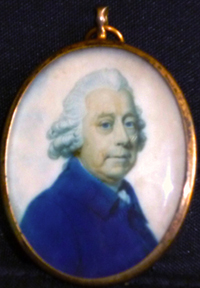

Born in 1742, Richard was the son of landed gentry and grew up in Knowle, near Cullompton in Devon. Deaf and dumb from birth, his talent for painting was recognised by his family from a young age. He studied at William Shipley’s drawing school and won a premium from the Society of Arts in 1758 at the age of 16. His miniatures were exhibited at the first exhibition of the Society of Artists in 1760 and in the second and subsequent exhibitions of the Royal Academy from 1770 to 1796. He worked from a house in Henrietta Street, near Covent Garden in London. In 1789, Richard was appointed as miniature painter in enamel to King George III. He died in 1810.
Crosse is a painter who, until the last century, has perhaps been underestimated. Basil Long in his book ‘British Miniaturists’ (1929) regarded Crosse as a very accurate draughtsman who painted without hesitation or retouching and who ‘will one day receive recognition for his sound, if modest, work’. Crosse’s miniatures often seem to be dominated by a shade of greenish-blue, maybe influenced by the early work of Joshua Reynolds.
A collection of original Crosse family papers, which the author has been privileged to view, are kept at the National Art Library in the Victoria & Albert museum. The collection includes Richard’s account books which record each sitter and the price paid for his or her miniature. For instance, in March 1763, a Mrs Gummings paid three guineas, eight shillings for her son’s miniature and one Count Weldon paid six guineas, six shillings for a picture of his dead child. By 1780, prices had increased to around eight guineas for a small miniature, ten guineas for a larger size.
From time to time, the papers are more than just facts and figures, hinting at a close-knit, supportive family. In 1779, Richard Crosse gave £2000 in stocks to his sister Elizabeth ‘in testimony of the affection and regard I have for her.’ Throughout the account books, scraps of old blotting paper can be found, covered with adding up and dividend calculations and signed ‘James Crosse of Knowle.’

| Home | The Book | Historical Background | J.D.Oswald | Register for updates | Look Inside & Buy |
© J.D. Oswald 2012. All rights reserved.
These papers however reveal nothing about the most tragic event of Crosse’s life, one that affected him until his death. In 1778, he proposed to his cousin Sarah Cobley. He was rejected - Sarah was already engaged to Benjamin Haydon - and it appears that he was deeply affected by his disappointment.
Although some of the events surrounding the main characters in Henrietta Street are inspired by the above accounts and papers, Flora Cobley is a purely fictional character and the events portrayed in the book during 1780 are imaginary.
